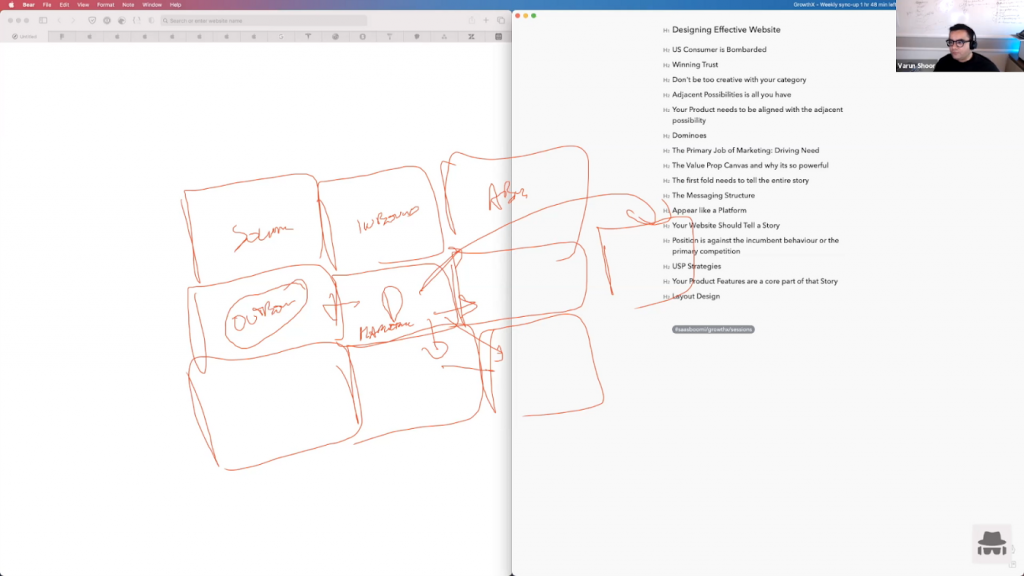
Let’s call it a series. We didn’t really intend on making it one. But the way things are turning out, it is shaping up to be one. A few weeks ago, a friend of ours set us on the path of what founders could do if they were planning to move to the US. We added another layer, where we talked about setting up a subsidiary in the US.
But once you have taken your company to the US, once you have taken the necessary steps — hired talent, identified your customers, and even sold your products to some of them — what is the next step you take?
Even if there is some chatter about your product in the market, you know that word-of-mouth marketing is not how you sell. To keep the business running smoothly, you will need more clients. Your product will need more buyers. And the first, very crucial step towards that is building a website.
Since founders want to sell in the US market, the website needs to appeal to the customers there. It needs to market products in a way that would appeal to the American customer. It needs to be smart, snappy, and well-drafted. And it needs to answer all customer queries swiftly and with ease. This is unfortunately not as easy as hiring a designer and an agency and you are good to go. It needs thought. We reached out to Varun Shoor, the founder of Kayako, a customer service software company based in London.
Varun has guided companies such as PipeCandy and Wingman in building their websites as part of the SaaSBOOMi GrowthX(SGx program). And so, you can understand that he knows this business better than most.

Varun Shoor — Founder of Kayako
A lot of people, he says, when designing their websites, think they need to use illustrations. And they don’t focus on the text. “About 80% of design is text. And don’t try to be very clever with it either. It will backfire,” he says.
Your categories need to be clear and not necessarily creative. So, it is best to not re-word or create fancy-sounding categories for yourself. When the customer lands on your page, they need to know what is happening here. They have come to you with a certain need, a certain demand. If your category does not end up defining those needs clearly, it will confuse the customer. They will leave thinking something completely different is happening here.
Varun himself had made this mistake with Kayako. The problem with naming categories is that they have become extremely commoditised. Varun was trying to make his product more visible. “We decided to call ourselves a customer experience platform. It was an absolute disaster,” he says.
The clients left when they realised they wanted a ticketing system or help desk software and Kayako was a customer experience platform. Despite the fact that Kayako was all of those things, the misleadingly creative name cost his company customers.
His experience taught him a lesson. But if your product is in a commoditized category, what do you do? “Embrace it. Don’t be something you aren’t. Think of the category you belong to and imagine the adjacent possibilities,” he says. This is another mistake people often make. Here’s how Varun explains it.

Imagine there is a grid of projects. You are at the centre of the grid. Now, if your category is marketing, the adjacent is inbound marketing, outbound marketing, and ABM. Once you decide to move to, say, ABM, your category changes. “Wherever your strengths lie, you have to choose that category and own it. Wholly and solely,” says Varun. But remember, move only one box at a time.
It starts with understanding what the customer wants and how their mind works. Founders have to understand that every customer, every day, is bombarded with thousands of ads. Every company is vying for their money. When they have so many choices in every category, why should they buy your product? Trust. The first thing you need to do is win their trust.
Winning anyone’s trust is not easy. And this is a new market that you are entering. How do you win the trust of American customers? You start by ensuring that the language you use is American. Don’t use exclamation points. Use American idioms and metaphors. Don’t make grammatical errors. Stick to American or British English.
You need to appear professional, someone who understands the way the American mind works. If you fail to deliver on these points, the customer will notice it. And there’s a good possibility that they won’t take you seriously.

Another point to keep in mind, he says, is subtlety. Whatever you are trying to say, try to say it with subtlety.
“Give customers subtle cues that begin with making your company look like it is based in the US,” Varun says.
Logo design, to the type of typeface, the pictures used, and even the English on the website. All of it has to be US-centric.
Another thing is the use of illustrations. “There has been an abuse of illustrations in the ecosystem and that is a terrible mistake,” he says. Illustrations take away the humanness of the brand.
“Use images of people instead. Faces of humans. So, even if your brand wants to show its Indianness, the vibe should still be Western.”
Tactically, founders need to start with the homepage. It is the first thing you see. “Homepage needs to be looked at like a customer journey,” says Varun. “A customer, when he comes to your website, will have several questions in his mind. Those questions are like dominoes.”
Let’s visualise this. Imagine there is a stack of dominoes lined up. These represent your customer’s journey from the start to the end. When you answer a stack of questions, they become aware of your product, and a domino set falls. Similarly, when they sign up for trials, when they become your customers, when they become your advocates and your champions, several dominoes have to fall in place for this journey to reach its completion. Each step is a milestone.
And how do you do this? He says that you begin with knowing what these dominoes are. You also need to know what an equivalent American business does. “Social proof and testimonials help you topple these dominoes,” Varun explains. Then, your messaging has to align with the problem the customer is facing. That’s another domino.
“Ask yourself, can you make the customer trust you as a business? Companies have weaker About Us pages. The three most clicked pages are Homepage, Pricing, and About Us. So, your website should have your American address. The photos you use have to be professional.” These are all dominos, remarks Varun.
When all these three dominoes fall, you have a successful sale. When designing the homepage, these are the dominoes that should fall at once.
Marketing, Varun explains, happens differently in the US. “It is all about driving the need,” he says. It is something that SaaS companies don’t understand, they haven’t been taught this lesson. While FMCG companies are complete pros at it. They make you feel you are missing out on something or are making a mistake by not buying their products. The seeds of fear, uncertainty, and doubt (FUD) are sowed in the customer’s mind. All to drive sales.
Take the example of soap.
“Soap is a category that one day suddenly became dominant. Companies like Unilever and P&G wanted growth in this category. So they began inventing needs,” he says. These companies said soap is bad for your hair, for your face. And we got shampoo and face wash. Then came the face washes for men and women. These companies, he explains, then created further classifications. After soaps came shower gels and those too, for men and women. Today when you go to buy a face wash, if you have acne, you will buy a face wash for acne.
“Identify a problem, create a new category and solve that problem and from there drive need.”
Varun stresses on the importance of driving the need. “Manufacture desire through messaging, pricing, and need.” Once you have identified the need, you know what you are selling. This is where, according to Varun, you will get your headline.
Think of this as the hero block.
“The hero block needs to answer all the questions in the minds of a visitor. If you don’t seem attractive enough, they will walk right by the store,” Varun says sharply.
Answer their three questions.
“And once again, these have to be answered in plain, clean, and American English,” he says. This forms the first fold of your website.
The logic, Varun says, is simple. If a prospective customer has landed on the homepage, your goal is to keep them engaged long enough until they become your customer. This page is your anchor for customer positioning.
You have to answer customer questions. But they aren’t here for leisure reading. If they don’t like the first headline they read, they are not going to read the rest. This is why your headline has to be witty and metaphorical. It should trigger pattern interrupt. And no one does that better than Apple.
When Apple was launching the M1 chip, the line they used was ‘small chip, giant leap’. This triggered memories of Neil Armstrong taking the first steps on the moon and conveyed that this chip is the future.
Have you seen the Indigo Airlines billboard that read “Phoren Return”? The second line said, “Daily flights from Mumbai to Bangkok + Dubai. Welcome aboard!”.
This is how the headline should be. The first line caught your attention. You already know what ‘phoren’ return shows. Using vernacular language establishes familiarity and evokes humour. And it makes you curious. The curiosity drives you to read the second line, which explains that they are offering tickets to Bangkok and Dubai. And once you have read this, finally comes the remaining information you need. The phone number and the web address, in this case.
“Once you get the customer hooked, you explain your product and they will read it,” says Varun.
Then there’s the question of naming your product features. Here, Varun offers a caveat. Branding, he says, is not about the logo or the text. Branding is about the emotion it triggers in the gut of your prospective customer. The way you name your features needs to bear that in mind. Apple uses simple terms like Facetime for its video feature. You are already familiar with the term. You know what it means. Tesla uses terms such as Autopilot and Summon. The latter triggers the boss-employee relationship. The car is in your employee. You are its master, you can summon it. These product features are a part of your core story.
There are some other valuable things to consider. The font, he says, that you choose will convey the personality of your brand. So if your brand is luxury you have to choose a font that expresses luxury. If it is a brand that caters to GenZ, you choose a font that has that young, carefree personality.
These may seem like little things, but they could make or break a sale. And with more companies choosing PLG as the way forward, the website becomes even more important. If you have some more nuances about catering to the US audience, please write to us here.
If you have an idea that you think we should hear, write to us here. Let’s grow the Indian SaaS story Together.
